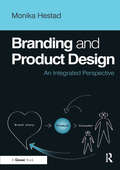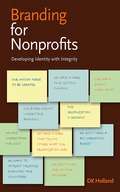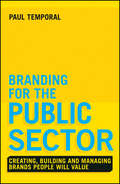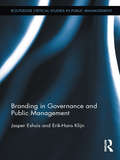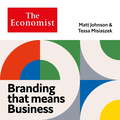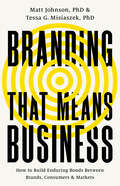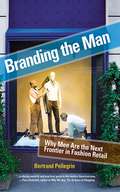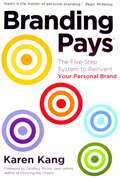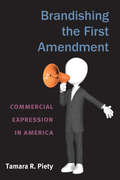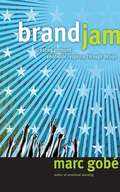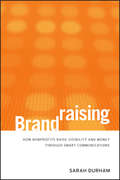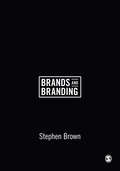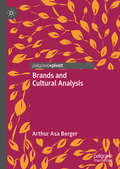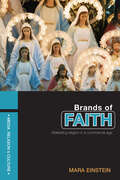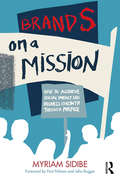- Table View
- List View
Branding and Product Design: An Integrated Perspective
by Monika HestadWhy do winning brands appear to be more creative and authentic than less successful ones? Despite the strong link between famous brands and the products sold under their name, there is still a gap in understanding the relationship between product design and brand-building - Monika Hestad plugs that gap. Branding and Product Design discusses key questions about the link between product and brand and about design processes and innovation. It examines these questions on both macro and micro levels and provides the reader with tools to help understand the role of products in building a brand, and how to bring the brand and the product design process together. These are based on the author's research into branding and product design, her years of teaching these topics, and her own industrial practice. Qualitative interviews delivering an 'insider' perspective on major brands bring abstract concepts to life. The book includes case studies from well-known and up-and-coming brands and will prove invaluable to design practitioners, marketers, managers and other professionals working close to designers. It will also benefit those teaching and studying, particularly if they are involved in the new higher education programmes where business schools and design schools are co-operating to reflect the intersection between design and branding.
Branding as Cultural Activism: An Agenda for Building Iconic Brands
by Douglas B. HoltTo systematically build iconic brands, companies must reinvent their marketing function. They must assemble cultural knowledge, rather than knowledge about individual consumers. They must strategize according to cultural branding principles, and they must hire and train cultural activists, rather than stewards of brand essence.
Branding for Bloggers: Tips to Grow Your Online Audience and Maximize Your Income
by New York Institute of Career Development Zach HellerThere are more than 54,000 new blogs started every day around the world. The stark reality is that most will fail because bloggers don't have enough information on marketing themselves. The key to any successful marketing plan is a strong brand. Branding for Bloggers features tried-and-true, it-worked-for-me methods of branding from a rich mix of professional bloggers and branding experts. Bloggers will learn how to define their brand, establish it to grow the reach of their blog, and use their new brand identities to start earning money online.
Branding for Nonprofits: Developing Identity With Integrity
by Dk HollandBranding for Nonprofits provides the processes, tools, and thinking needed to brand or rebrand. Author DK Holland-a pioneer in the field-helps nonprofits approach the rebranding process with confidence and enthusiasm. Case studies reveal real-life situations in which nonprofits have successfully created branding opportunities out of dilemmas, creating a distinctinve, clear identity that furthers their mission. Inspiring and demystifying, this book is the essential tool for nonprofits seeking to communicate their important work in a bold voice. Addresses the connection between branding and fund-raising There are 1.6 million nonprofits in the United States. Stand out from the crowd!
Branding for the Public Sector
by Paul TemporalHow to apply for-profit marketing strategies to non-profitorganizationsBranding for the Public Sector presents powerful and effectivebranding strategies for the public sector illustrated through casestudies and examples. The book covers branding architecture, brandvision, market research, brand perception, engagement,communication, managing brand change and much more. Additionally,the book highlights the future of public sector branding and howorganizations in the public sector may be a key driver of economicgrowth and prosperity through the twenty-first century. Brandingfor the Public Sector offers expert guidance for managers andleaders who want to build powerful, influential brands in thepublic sector.* Presents strategies and actions for building a powerful,memorable public sector brand* Explains why the public sector will be the next huge growthsector in branding* Explores the competencies needed to successfully manage apublic sector brand
Branding in Governance and Public Management (Routledge Critical Studies in Public Management)
by Jasper Eshuis E.H. KlijnPoliticians and public managers utilize branding to communicate with the public as well as to position themselves within the ever-present media now so central to political and administrative life. They must further contend with stakeholders holding contradictory opinions about the nature of a problem, the desirable solutions , and the values at stake. Branding is used as a strategy to manage perceptions, motivate stakeholders, communicate clear messages in the media, and position policies and projects. Brands have a unique ability to simplify such messages and motivate different actors to invest their energy in governance processes. Public administration scholars so far have however paid little attention to branding. This book provides a systematic analysis of branding as phenomenon in governance. It deals with the nature of public branding, its relation to existing theories in public administration, the way branding is used as a managerial strategy in governance processes, and the risks and limitations of branding. Branding in Public Governance and Management highlights the growing importance of public banding as a public management strategy to influence political events, decision-making processes and outcomes in governance processes.
Branding in a Competitive Marketplace
by Rajat K BaisyaIn a fiercely competitive marketplace, brand marketers need innovative ideas and strategies that will make their brand stand out in a clutter and result in definite sales. Branding in a Competitive Marketplace discusses core issues in brand management-the concept of brand, its value, and its strategic management. It also covers brand extension, brand positioning, brand acquisition, and brand valuation and divestment as well as new models for successfully managing brands in a competitive business environment. The book has numerous real-life examples from brands like Mortein, Kingfisher, Godrej, Canon, Ujala, and Nirula's to illustrate its points. It also includes live cases to highlight the elements of branding that made those brands successful. These cases also show how marketers methodically projected their brand's superiority over competitors' and succeeded in winning the consumer's mind-space. The book has been designed to provide brand marketers with systematic lessons on strategic thinking, strategic planning and strategic actions.
Branding that Means Business: Economist Edge: books that give you the edge
by Matt Johnson Tessa MisiaszekBrands are all around us, more entwined with our lives than ever before. They have the power to shape not just what we buy, but how we act and how we feel about ourselves.Knowing how brands are built and add value has always been an important business skill. But, as the rules of engagement shift and change, it's become crucial. No longer the exclusive preserve of marketeers and brand managers, we all need to understand the deep interplay between brands, consumers and society in general.With traditional communication channels imploding and internet platforms and influencers riding high, it's more important than ever that we focus on one key constant: brands only matter when they mean something to our consumers and customers. And that means understanding not just the dynamics of our markets, butalso the fundamentals of human nature and behaviour.Branding that Means Business offers a new approach that will show you how to build a meaningful brand.
Branding that Means Business: How to Build Enduring Bonds between Brands, Consumers and Markets
by Matt Johnson Tessa G MisiaszekA revelatory guide on how to build, sustain and grow a brand. A brand is either beloved, or it&’s noise. We live in a fast-paced world of immediate gratification where consumers can listen to any song, watch any movie, or read any article, with the touch of a few buttons. They are peppered with hyper-personalized targeting for products that can be ordered seamlessly and arrive within hours. And if your brand isn&’t the first to come to mind, they&’ll click that button and it&’ll be delivered by someone else. So how do you make sure your brand connects with consumers? Branding that Means Business draws from the authors&’ experience and business literature as well as psychology, sociology, and even anthropology to show readers that while any brand serves the business, the mechanisms that enable it are all about connecting with people. Readers will learn how to create, maintain, and operationalize their brand, and think creatively about how to differentiate their product and most importantly, make consumers fall in love with it.
Branding the Man
by Bertrand PellegrinBrand strategist and retail consultant Bertrand Pellegrin breaks down the psychological and sociological elements that influence men's clothing choices, and what they mean to retail clothiers. This is much more detailed than just "clothes make the man", and includes case studies to illustrate how an understanding of male clothing behaviors can be translated into successful retail sales. Annotation c2010 Book News, Inc. , Portland, OR (booknews. com)
Branding the Man: Why Men Are the Next Frontier in Fashion Retail
by Bertrand PellegrinMen are purchasing more clothes, shoes, health and beauty products, and personal care services than ever before. The world of men's retail has remained a kind of bug in amber, frozen in time, with the same century-old style of merchandising and selling. A store must not simply provide, but educate the male customer, who is growing hungry for something more than the usual Blue Plate Special of khakis and polo shirts. To better attract this new wave of interested consumers, products in the U.S. must be merchandised and sold in a completely different manner. The design and branding of a man's store ought to make men want to go shopping. Branding the Man offers retailers, buyers, and marketers strategic solutions to revolutionize men's retail via some relatively simple conceptual strategies. Author Bertrand Pellegrin utilizes his years as a retail strategist to help retailers understand classic men's environments-ones where men are most naturally inclined to spend time-and leverage the opportunities which arise from these "comfort zones" to engage and sell to the male customer. Branding the Man immerses the reader in a discussion of men's retail environments spanning every level: store design, buying/sourcing, merchandising, marketing and advertising, and promotion and lays out a blueprint for how men can be developed as the "next frontier" in retail.
Branding: Differentiation that Customers Value
by Richard LueckeSelling a product or service is easy when it operates as it should, is easy to buy and operate, and is backed by customer service--and many products may fall into this category. But branding is what relates your logo and name to perpetual high quality in the mind of a customer and keeps him coming back to you for a second purchase. In this chapter, the authors introduce basic branding strategy as well as warn of over-differentiation, which may make the advertising staff happier with a novel product to sell but may leave the customer unsatisfied, resulting in a loss of customer equity.
BrandingPays: The Five-Step System to Reinvent Your Personal Brand
by Karen KangGlobalization and social media have made the world smaller, more connected and infinitely more competitive. The world has changed. Have you? If you don't have the package that will take you to the next level of your career, you need to reinvent your personal brand.
Brandishing the First Amendment: Commercial Expression in America
by Tamara R. PietyOver the past two decades, corporations and other commercial entities have used strategic litigation to win more expansive First Amendment protections for commercial speech-from the regulation of advertising to the role corporate interests play in the political process, most recently debated in the Supreme Court case ofCitizens United v. Federal Election Commission. Tamara R. Piety, a nationally known critic of commercial and corporate speech, argues that such an expansion of First Amendment speech rights imperils public health, safety, and welfare; the reliability of commercial and consumer information; the stability of financial markets; and the global environment. Beginning with an evaluation of commonly evoked philosophical justifications for freedom of expression, Piety determines that, while these are appropriate for the protection ofan individual's rights,they should not be applied too literally tocommercialexpression because the corporate person is not the moral equivalent of the human person. She then gathers evidence from public relations and marketing, behavioral economics, psychology, and cognitive studies to show how overly permissive extensions of First Amendment protections to commercial expression limit governmental power to address some of the major social, economic, and environmental challenges of our time. "The timeliness of the topic and the provision of original positions are sure to make the book a valuable contribution that should draw much attention. " -Kevin W. Saunders, Michigan State University
Brandjam: Humanizing Brands Through Emotional Design
by Marc GobeBrandjam, the follow-up to the groundbreaking best-seller Emotional Branding, presents a powerful new concept from renowned designer and business guru Mark Gobe. The Brandjam concept is about innovation, intuition, and risk. Gobe explains how design is the "instrument" companies can use for jazzing up a brand-how design puts the face on the brand and creates an irresistible message that connects buyers to the product in a visceral way. Using jazz as his metaphor, he shows how the instinctive nature of the creative process leads to unusual solutions that make people gravitate toward a brand and make brands resonate with people by bringing more joy into their lives. It explores how design represents the personality of a company and provides its window to the world. Brandjam is an inspiration for brands and people as it reveals the transforming impact brands have on their audience. Follow-up to Emotional Branding-50,000 copies sold in nine languages Insider's look at creating powerful, compelling brands and identities Exciting new ideas for using design to drive consumers to embrace brands
Brandraising
by Sarah DurhamIn the current economic climate, nonprofits need to focus on ways to stand out from the crowd, win charitable dollars, and survive the downturn. Effective, mission-focused communications can help organizations build strong identities, heightened reputations, and increased fundraising capability. Brandraising outlines a mission-driven approach to communications and marketing, specifically designed to boost fundraising efforts. This book provides tools and guidance for nonprofits seeking to transform their communications and marketing through smart positioning, branding, campaigns, and materials that leverage solid strategy and great creative, with a unique focus on the intersection of communications and fundraising.
Brands and Brand Management: Contemporary Research Perspectives (Marketing And Consumer Psychology Ser.)
by Barbara Loken Rohini Ahluwalia Michael J. HoustonVery few books exist that meaningfully integrate the rich and vast body of scientific research and theories that have accumulated in the field, relating to both traditional and contemporary topics in branding. This book accomplishes that task, with contributions from leading experts in the science of branding, national and international. The book should appeal to all students, faculty, and marketing professionals with an interest in research findings about brands, and an interest in deepening their understanding of how consumers view brands.
Brands and Branding
by Douglas B. HoltDevelops a cultural framework for thinking about what a brand is and how firms shape their brands through their marketing activities. Four dimensions of the brand are described: economic, social, psychological, and symbolic.
Brands and Branding
by Stephen BrownA fun and humorous introductory book, written in Stephen Brown′s entertaining and highly distinctive style, that introduces curious readers to the key components of brands and helps them to begin to make sense of them - what they are, what they do, why and how - using plenty of examples and references drawn from a wide range brands such as Amazon, Apple, Google, Gucci, Nike, Nintendo, Starbucks, Swatch and The Worst Hotel in the World. With 3,000 branding books published each year, why would you (or your students) want to read Brands & Branding? Here are seven reasons why: It’s introductory, aimed at undergraduate students or postgrads without a bachelor degree in business and assumes nothing more than readers’ awareness of high profile brands such as Coca-Cola, Microsoft and Chanel It’s indicative, focusing on the basics and thus being a more reliable revision aid than Lucozade It’s immersive, taking readers on a journey and, working on the assumption that they have smartphones or tablet computers to hand, the print text links to images, articles and academic publications to give emphasis and context where appropriate. It’s inclusive, considering articles and reports but also blogs, novels, newspapers, reviews, social media and other sources It’s irreverent – branding is not always a deadly serious business! It’s intimate, Stephen speaks to you directly and together you will pick your way through the sometimes weird and unfailingly wonderful world of brands and branding using examples rather than abstract ideas to illustrate points. It’s inspirational, celebrating the curious and successful stories of brands from Cillit Bang to Cacharel Suitable for first and second year marketing or advertising students, and for those new to or interested in branding and who are keen to know more.
Brands and Branding: Strategy to Build and Nurture Brands
by Ashita Aggarwal Suraj CommuriThis volume examines the importance of strategic brand imaging and brand management. It covers the fundamentals of launching, growing, leveraging, and managing brands in a global context, the strategic decisions related to brand building, and the integration of the 4Ps in implementing the brand strategy. The book presents a practical perspective on building brands through social media and using artificial intelligence technologies. Readers will get a clear introductory understanding about the role of consumer behavior, the research methods that every brand manager must be familiar with, brand architecture, portfolio, brand equity and valuation. Branding requires vision to foresee, logic to understand the market and the art of understanding consumers. This book is a guide for readers and professionals who are interested in all aspects of branding and brand building. It will also be useful for scholars and students of Marketing, Advertising and Brand Management, Business studies, Business Communication, Media and Journalism and Public Relations; and for marketing professionals as it will help them understand fundamentals and practical application of brand management.
Brands and Consumers: A Research Overview (State of the Art in Business Research)
by Jaywant Singh Benedetta CrisafulliBrand management is firmly established as a core business and marketing activity. The research evidence on how consumers react to branding, however, is in constant evolution globally. This short-form book provides a comprehensive overview of research evidence on several core branding topics whilst acting as a catalyst for advancing future research and informing business practice. The book fills a gap created by prior volumes on branding that, although well- illustrated and explained, have often approached the subject in somewhat uncritical manner. The book represents a timely compendium on popular topics in branding and aims to be a valuable addition to knowledge in branding. The book focuses on reviewing research in branding and brand management, and proposes areas for expanding research in the field. Recognising the diversity of research in branding, the authors of this book, as active branding researchers, attempt to discuss the limitations of current research and provide insights for future explorations. The book will be of interest and a resource for academic researchers, branding practitioners, business students and policymakers who view branding as an evidence-oriented discipline.
Brands and Cultural Analysis
by Arthur Asa BergerThis book, written in an accessible style with numerous illustrations and with drawings by the author, discusses what brands are and the role brands play in American society and consumer cultures, in general. The book uses a cultural studies approach and draws upon concepts and theories from semiotics, psychoanalytic theory, sociological theory, discourse theory, and other related fields. It also quotes from a number of important thinkers whose ideas offer insights into various aspects of brands. Brands has chapters on topics such as what brands are, their role in society, brands and the psyche, brands and history, language and brands, the marketing of brands, brands and logos, the branded self, San Francisco and Japan as brands, brand sacrality, multi-modal discourse analysis and brands, and competition among brands.
Brands of Faith: Marketing Religion in a Commercial Age (Media, Religion and Culture)
by Mara EinsteinIn a society overrun by commercial clutter, religion has become yet another product sold in the consumer marketplace, and faiths of all kinds must compete with a myriad of more entertaining and more convenient leisure activities. Brands of Faith argues that in order to compete effectively faiths have had to become brands – easily recognizable symbols and spokespeople with whom religious prospects can make immediate connections Mara Einstein shows how religious branding has expanded over the past twenty years to create a blended world of commerce and faith where the sacred becomes secular and the secular sacred. In a series of fascinating case studies of faith brands, she explores the significance of branded church courses, such as Alpha and The Purpose Driven Life, mega-churches, and the popularity of the televangelist Joel Olsteen and television presenter Oprah Winfrey, as well as the rise of Kaballah. She asks what the consequences of this religious marketing will be, and outlines the possible results of religious commercialism – good and bad. Repackaging religion – updating music, creating teen-targeted bibles – is justifiable and necessary. However, when the content becomes obscured, religion may lose its unique selling proposition – the very ability to raise us above the market.
Brands on a Mission: How to Achieve Social Impact and Business Growth Through Purpose
by Myriam SidibeBrands on a Mission explores the importance of creating a performance culture that is built on driving impact through purpose, and the type of talent required to drive these transformational changes within companies – from CEO to brand developers. Using evidence from interviews and stories from over 100 CEOs, thought leaders and brand managers, the book presents an emergent model that organisations can follow to build purpose into their growth strategy – and shows how to bridge the gap between Brand Say and Brand Do. Readers will learn from the real experts in the field: how Paul Polman, former CEO of Unilever, built purpose into the DNA of his company; what keeps Alan Jope (new CEO, Unilever) and Emmanuel Faber (CEO, Danone) awake at night; and how brand developers from Durex, Dove, Discovery and LIXIL have made choices and the reasons behind them. In this book you will learn how a soap brand Lifebuoy taught one billion people about hygiene, how a beer is tackling gender-based violence, and how a toothpaste is tackling school absenteeism amongst many others. Renowned experts like Peter Piot (Director, London School of Health and Tropical Medicine), Michael Porter (Professor, Harvard School of Business), Jane Nelson (Director, Corporate Responsibility Initiative, Harvard Kennedy School) and Susie Orbach (leading feminist and formerly professor, London School of Economics) also share examples, data and their everyday experiences of helping corporates create a culture of purpose. And leading NGOs and UN experts like Lawrence Haddad (Executive Director, GAIN) and Natalia Kanem (Executive Director of UNFPA) will recount how the public and private sector have worked together to create an accelerated path to reaching the Sustainable Development Goals by 2030. The book provides a clear pathway of how to take brands through the journey of developing impactful social missions and driving business growth, and is an essential guide for both managers and students alike.
